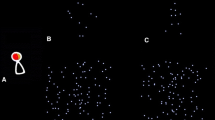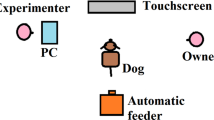Abstract
Abnormal stereotypic behaviour is widespread among captive non-human primates and is generally associated with jeopardized well-being. However, attributing the same significance to all of these repetitive, unvarying and apparently functionless behaviours may be misleading, as some behaviours may be better indicators of stress than others. Previous studies have demonstrated that the affective state of the individual can be inferred from its bias in appraising neutral stimuli in its environment. Therefore, in the present study, in order to assess the emotional state of stereotyping individuals, 16 captive tufted capuchins (Cebus apella) were tested on a judgment bias paradigm and their faecal corticoid levels were measured in order to assess the intensity of the emotional state. Capuchins with higher levels of stereotypic head twirls exhibited a negative bias while judging ambiguous stimuli and had higher levels of faecal corticoids compared to subjects with lower levels of head twirls. Levels of stereotypic pacing, however, were not correlated with the monkeys’ emotional state. This study is the first to reveal a positive correlation between levels of stereotypic behaviour and a ‘pessimistic’-like judgment bias in a non-human primate by employing a recently developed cognitive approach. Combining cognitive tests that evaluate the animals’ affective valence (positive or negative) with hormonal measurements that provide information on the strength of the emotional state conduces to a better understanding of the animals’ affective state and therefore to their well-being.






Similar content being viewed by others
References
Bateson M, Matheson SM (2007) Performance on a categorisation task suggests that removal of environmental enrichment induces ‘pessimism’ in captive European starlings (Sturnus vulgaris). Anim Welf 16(Supplement 1):33–36
Beehner JC, Whitten PL (2004) Modifications of a field method for fecal steroid analysis in baboons. Physiol Behav 82(2–3):269–277
Bell ME, Wood CE, Keller-Wood M, Kane C, Kluwe C, Manlove E, Taranovich C, Johnson J (1991) Influence of reproductive state on pituitary-adrenal activity in the ewe. Domest Anim Endocrinol 8(2):245–254
Brilot B, Asher L, Bateson M (2010) Stereotyping starlings are more “pessimistic”. Anim Cogn 13(5):721–731. doi:10.1007/s10071-010-0323-z
Brydges NM, Leach M, Nicol K, Wright R, Bateson M (2011) Environmental enrichment induces optimistic cognitive bias in rats. Anim Behav 81(1):169–175
Clubb R, Mason G (2003) Animal welfare: captivity effects on wide-ranging carnivores. Nature 425(6957):473–474
Coiro V, Volpi R, Casti A, Maffei ML, Stella A, Volta E, Chiodera P (2011) Naloxone decreases the inhibitory effect of alprazolam on the release of adrenocorticotropin/cortisol induced by physical exercise in man. Br J Clin Pharmacol 71(6):951–955. doi:10.1111/j.1365-2125.2010.03900.x
Dawkins MS (2003) Behaviour as a tool in the assessment of animal welfare. Zoology 106(4):383–387
Dawkins MS (2006) A user’s guide to animal welfare science. Trends Ecol Evol 21(2):77–82
Dayas CV, Buller KM, Day TA (1999) Neuroendocrine responses to an emotional stressor: evidence for involvement of the medial but not the central amygdala. Eur J Neurosci 11(7):2312–2322. doi:10.1046/j.1460-9568.1999.00645.x
Dickerson SS, Kemeny ME (2004) Acute stressors and cortisol responses: a theoretical integration and synthesis of laboratory research. Psychol Bull 130(3):355–391
Diener E, Oishi S, Lucas RE (2003) Personality, culture, and subjective well-being: emotional and cognitive evaluations of life. Annu Rev Psychol 54(1):403–425. doi:10.1146/annurev.psych.54.101601.145056
Garner JP (2005) Stereotypies and other abnormal repetitive behaviors: potential impact on validity, reliability, and replicability of scientific outcomes. ILAR 46(2):106–117
Garner JP (2006) Perseveration and stereotypy—system-level insights from clinical psychology. In: Mason GJ, Rushen J (eds) Stereotypic animal behaviour: fundamentals and applications to welfare, 2nd edn. CABI, Wallingford, pp 121–152
Garner JP, Meehan CL, Mench JA (2003) Stereotypies in caged parrots, schizophrenia and autism: evidence for a common mechanism. Behav Brain Res 145(1–2):125–134
Hockly E, Cordery PM, Woodman B, Mahal A, Van Dellen A, Blakemore C, Lewis CM, Hannan AJ, Bates GP (2002) Environmental enrichment slows disease progression in R6/2 Huntington’s disease mice. Ann Neurol 51(2):235–242. doi:10.1002/ana.10094
Keay JM, Singh J, Gaunt MC, Kaur T (2006) Fecal glucocorticoids and their metabolites as indicators of stress in various mammalian species: a literature review. J Zoo Wildl Med 37(3):234–244. doi:10.1638/05-050.1
Koolhaas JM, Meerlo P, de Boer SF, Strubbe JH, Bohus B (1997) The temporal dynamics of the stress response. Neurosci Biobehav Rev 21:775–782
Lanovaz MJ (2011) Towards a comprehensive model of stereotypy: integrating operant and neurobiological interpretations. Res Dev Disabil 32(2):447–455
Leknes S, Tracey I (2008) A common neurobiology for pain and pleasure. Nat Rev Neurosci 9(4):314–320
Lewis MH, Bodfish JW (2007) Repetitive behavior disorders in autism. Ment Retard Dev Disabil Res Rev 4:80–89
Lupien SJ, Maheu F, Tu M, Fiocco A, Schramek TE (2007) The effects of stress and stress hormones on human cognition: Implications for the field of brain and cognition. Brain Cogn 65(3):209–237
Martin P, Bateson P (1993) Measuring behaviour, 2nd edn. Cambridge University Press, Cambridge
Mason G (1991) Stereotypies and suffering. Behav Process 25(2–3):103–115
Mason GJ, Latham NR (2004) Can’t stop, won’t stop: is stereotypy a reliable animal welfare indicator? Anim Welf 13:57–69
Mason G, Rushen J (2006) Stereotypic animal behaviour: fundamentals and applications to welfare, 2nd edn. CABI Pub, Wallingford
Mason GJ, Cooper J, Clarebrough C (2001) Frustrations of fur-farmed mink. Nature 410(6824):35–36
Matheson SM, Asher L, Bateson M (2008) Larger, enriched cages are associated with ‘optimistic’ response biases in captive European starlings (Sturnus vulgaris). Appl Anim Behav Sci 109(2–4):374–383
Mendl M, Burman OHP, Parker RMA, Paul ES (2009) Cognitive bias as an indicator of animal emotion and welfare: emerging evidence and underlying mechanisms. Appl Anim Behav Sci 118(3):161–181
Mendl M, Brooks J, Basse C, Burman O, Paul E, Blackwell E, Casey R (2010a) Dogs showing separation-related behaviour exhibit a ‘pessimistic’ cognitive bias. Curr Biol 20(19):R839–R840
Mendl M, Burman OHP, Paul ES (2010b) An integrative and functional framework for the study of animal emotion and mood. Proc R Soc B Biol Sci 277(1696):2895–2904. doi:10.1098/rspb.2010.0303
Mills DS (2003) Medical paradigms for the study of problem behaviour: a critical review. Appl Anim Behav Sci 81(3):265–277
Moberg GP (2001) Biological response to stress: implications for animal welfare. In: Moberg GP, Joy AM (eds) The biology of animal stress: basic principles and implications for animal welfare. CABI, New York, pp 1–22
Paul ES, Harding EJ, Mendl M (2005) Measuring emotional processes in animals: the utility of a cognitive approach. Neurosci Biobehav Rev 29(3):469–491
Polivy J (1998) The effects of behavioral inhibition: integrating internal cues, cognition, behavior, and affect. Psychol Inq 9(3):181–204. doi:10.1207/s15327965pli0903_1
Pomerantz O, Terkel J (2009) Effects of positive reinforcement training techniques on the psychological welfare of zoo-housed chimpanzees (Pan troglodytes). Am J Primatol 71(8):687–695. doi:10.1002/ajp.20703
Puliafico A, Kendall P (2006) Threat-related attentional bias in anxious youth: a review. Clin Child Fam Psychol Rev 9(3):162–180. doi:10.1007/s10567-006-0009-x
Quirke T, O’Riordan RM (2011) The effect of a randomised enrichment treatment schedule on the behaviour of cheetahs (Acinonyx jubatus). Appl Anim Behav Sci 135(1–2):103–109
Reinhardt V (2002) In: Comfortable quarters for laboratory animals. (9th edn.), Animal Welfare Institute, Washington DC
Rutter M, Andersen-Wood L, Beckett C, Bredenkamp D, Castle J, Groothues C, Kreppner J, Keaveney L, Lord C, O’Connor TG (1999) Quasi-autistic patterns following severe early global privation. J Child Psychol Psychiatry Allied Discipl 40:537–549
Salmeto AL, Hymel KA, Carpenter EC, Brilot BO, Bateson M, Sufka KJ (2011) Cognitive bias in the chick anxiety-depression model. Brain Res 1373:124–130
Stewart CL, Boyle LA, O’Connell NE (2011) The effect of increasing dietary fibre and the provision of straw racks on the welfare of sows housed in small static groups. Anim Welf 20(4):633–640
Wasser SK, Hunt KE, Brown JL, Cooper K, Crockett CM, Bechert U, Millspaugh JJ, Larson S, Monfort SL (2000) A generalized fecal glucocorticoid assay for use in a diverse array of nondomestic mammalian and avian species. Gen Comp Endocrinol 120(3):260–275
Weingrill T, Willems EP, Zimmermann N, Steinmetz H, Heistermann M (2011) Species-specific patterns in fecal glucocorticoid and androgen levels in zoo-living orangutans (Pongo spp.). Gen Comp Endocrinol 172(3):446–457
Wiedenmayer C (1997) Causation of the ontogenetic development of stereotypic digging in gerbils. Anim Behav 53(3):461–470
Wurbel H (2001) Ideal homes? Housing effects on rodent brain and behaviour. Trends Neurosci 24(4):207–211
Acknowledgments
We wish to thank Ernest Davis, Seth Bower On Pomerantz, and Naomi Paz for her help in preparing and editing this manuscript.
Author information
Authors and Affiliations
Corresponding author
Rights and permissions
About this article
Cite this article
Pomerantz, O., Terkel, J., Suomi, S.J. et al. Stereotypic head twirls, but not pacing, are related to a ‘pessimistic’-like judgment bias among captive tufted capuchins (Cebus apella). Anim Cogn 15, 689–698 (2012). https://doi.org/10.1007/s10071-012-0497-7
Received:
Revised:
Accepted:
Published:
Issue Date:
DOI: https://doi.org/10.1007/s10071-012-0497-7




